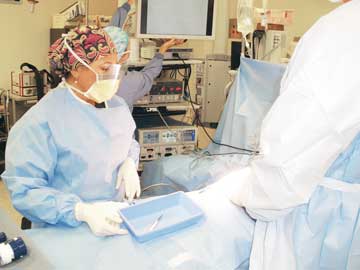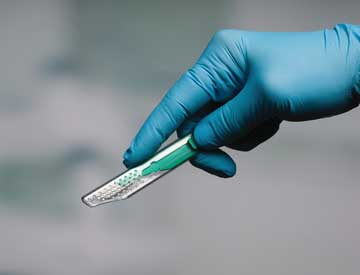Six Surface Disinfection Concepts
The puzzle of superior surface disinfection is never solved....
This website uses cookies. to enhance your browsing experience, serve personalized ads or content, and analyze our traffic. By clicking “Accept & Close”, you consent to our use of cookies. Read our Privacy Policy to learn more.
By: Adam Taylor | Senior Editor
Published: 5/5/2022
If you doubt the contention that it can take years — or even decades — for evidence to trickle into clinical practice, look no further than the lack of progress in implementing simple precautions to prevent avoidable staff injuries from needles, scalpels, syringes and other sharp surgical instruments.
An estimated 385,000 hospital workers in the U.S. suffer a sharps injury each year and nearly half of the incidents take place in operating rooms, making them the leading clinical area in which the injuries occur, says Renae Wright, DNP, RN, CNOR, perioperative practice specialist with the Association of periOperative Registered Nurses (AORN). Sharps injuries are believed to take place in as many as 15% of surgeries. One 2019 review concluded that surgeons suffered a sharps injury in one of every 10 operations. Dr. Wright says 64% of the injuries are estimated to be preventable and that as many as 90% of them go unreported. “We haven’t seen a whole lot of improvement in this area,” she adds.
Deborah L. Spratt, MPA, BSN, RN, CNOR, CHL, agrees. “It’s 2022, two years after the 20th anniversary of OSHA’s Needlestick Safety and Prevention Act, and here we are, talking about the same thing,” says Ms. Spratt, a perioperative consultant based in Rochester, N.Y. “We’re still not getting it right.”
Implementing a successful sharps safety program requires a culture change in any facility embarking on it. Fortunately, Ms. Spratt is beginning to see a shift in willingness among surgical professionals to make the necessary conversions and notices more surgeons being amicable to making practice changes that benefit the safety of the entire OR team.
Ms. Spratt had the opportunity to work on a successful sharps safety program at University of Rochester Medical Center’s St. James Hospital in Hornell, N.Y., a newly constructed four-OR, 16-bed facility that opened in March 2020. Implementing the program was helped by the fact that the facility was brand new, which made introducing new practices a natural. The program was also successful in part because the hospital’s grand opening coincided with the pandemic, so surgeries weren’t immediately ramped up to full levels. “It was an opportunity to educate and implement the use of double gloves, neutral passing zones, and discuss retractable scalpels and blunt-tip suture needles,” says Ms. Spratt. “We were able to ease into it and really focus on team safety.”
The perioperative staff at St. James were using some safety scalpels and blunt-tip suture needles when appropriate and were disposing of sharps in safe ways. They were not routinely using a neutral zone, however. Double gloving wasn’t a standard practice, and when it was used, an indicator glove system wasn’t in place. The staff was educated using the AORN Guideline for Sharps Safety on why these measures were important and how to implement them as part of a new culture of safety. The improvements they made in all four areas could be used to drive similar sharps safety gains in your facility.

• Double glove. The St. James staff switched to a latex-free bio-gel double glove system, which includes a colored underglove indicator, so staff can easily tell when the outer layer has been punctured. The glove vendor was part of the staff education process that advised staff on how to properly size the outer and inner gloves and the added safety of wearing two layers of protection. For example, the volume of blood on a suture needle is vastly reduced when it passes through two gloves, decreasing the viral load from a needlestick. Additionally, the risk of exposure to a patient’s blood is significantly decreased when the outer glove is punctured if an indicator underglove is worn because staff can more easily notice tiny perforations in the outer glove and immediately don a new pair.
The education sessions also helped to address the concerns of surgical team members — surgeons in particular — who pushed back on making the switch to double gloves because of fears they’d lose tactile sensation at their fingertips. For services such as ophthalmology, a risk analysis should be done because the surgeon is often working under a microscope without an assistant’s hand’s in the field and with very small suture needles.
• Use neutral zones. Instituting a hand-free passing area for the exchange of sharps at the sterile field is easier said than done, says Ms. Spratt. There are multiple barriers to starting the practice and making sure it remains in place, from staff who don’t believe the lack of a zone is an issue to surgeons not wanting to introduce an additional step into surgery.
“Some scrub techs take great pride in their ability to pass a suture needle directly into the surgeon’s hand without incident,” says Ms. Spratt. “But the entire team needs to know there’s a sharp present on the field, and there’s nothing wrong with putting in into a kidney basin or a tray from the custom pack, or onto a magnetic mat.”
The surgical team should identify the neutral zone during the timeout. Verbal notifications should be made each time a sharp is dropped into the zone and the items should be placed in a way that facilitates easy retrieval by surgeons, their assistants or scrub techs. Also, sharps should only be handled by one surgical team member at a time.
• Invest in safety devices. While staples and other new closure devices have reduced the amount of suturing that takes place, blunt-tip suture needles are still appropriate for use in fascia closures, muscle and perineal
lacerations, and episiotomy repairs. Safety-engineered scalpels include single-use models, shielded or sheathed blades that can be covered when not in use,
models featuring blades with rounded tips and devices with retractable
blades that go into the handle when they’re being put into neutral zones or passed from one team member to another. When use of safety-engineered scalpels isn’t clinically realistic, the blades of conventional scalpels should be
removed from the handle with a single-handed removal device.

• Promote proper disposal. While sharps are on the sterile field, they should be placed in temporary receptacles that are leak-proof, puncture resistant and labeled to denote they contain devices that could harbor bloodborne pathogens. Sharps disposal containers should always be in the upright position, replaced before they’re overfilled and securely closed at all times. The containers should allow team members to deposit sharps with one hand, have design features that prevent hands from entering and have tamper-free locks in place. For more information on proper sharps disposal, check out the National Institute for Occupational Safety and Health’s (NIOSH) guidelines.
It's simple situational awareness. Make sure all sharps are properly disposed of before the case is considered over.
— Deborah Spratt
A key benefit of sharps disposal containers is they prevent downstream personnel from getting injured. Leaving needles or blades in case carts can cause a sterile processing technician to be injured. Throwing exposed sharps in the trash could harm environmental services workers and leaving a scalpel in a blanket could hurt the employees who clean the linens. “All those workers are part of the larger surgical team and none of them deserves to suffer a sharps injury,” says Ms. Spratt. “It’s simple situational awareness. Make sure all sharps are properly disposed of before the case is considered over.”
The world of surgery has come a long way since the days when most surgeons felt emboldened to dictate what happens in the OR and demanded to have scalpels placed in their hand just so or refused to use devices that would protect themselves and others in the sterile field, yet there’s still much room for growth. “You can’t provide safe patient care if the team isn’t safe,” says Ms. Spratt. “The operating room is a team sport. Collective changes in practices are needed to benefit the entire team and their patients.” OSM
The puzzle of superior surface disinfection is never solved....
Boston Children’s Hospital is renowned for its exemplary care on many fronts, including surgery....
Manual cleaning done properly is effective for eradicating microorganisms....